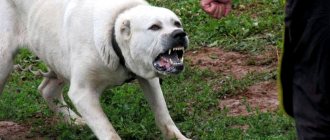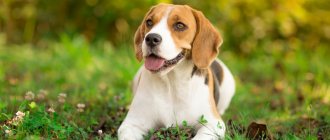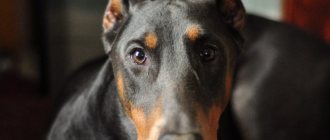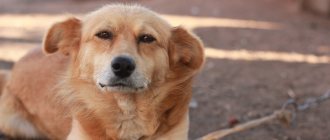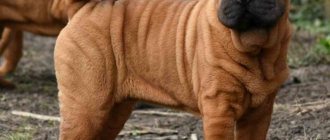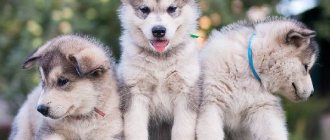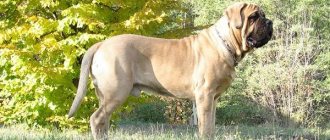- Dogs
A dog is man's best friend, everyone has known this for many years. However, there are not just friends, but real savers of human lives. Some breeds are better than others amenable to training to provide first aid in any extreme situation - we’ll talk about them in the article.
Of course, special, exaggerated requirements are put forward for dogs that are called upon to save human lives:
- Excellent sense organs: eyes, ears, nose.
- Determined but good-natured character. The dog must make good contact with any person, because hundreds of different “souls” will have to be saved.
- Good physical fitness and endurance. On the path to a noble goal, you will certainly have to overcome many obstacles.
- Stable nervous system. The dog will have to work hard, and he must always be in excellent shape.
- Obedience. The dog must be easy to train.
What can a rescue dog do?
Bloodhounds specialize in finding missing people and rescuing them in critical situations. They are required to perfectly, even in pitch darkness and bad weather, search various territories in a short time, including moving over rough terrain; carry out searches in rubble and ruins resulting from dam breaks, fires, explosions due to gas leaks, floods, earthquakes and other natural disasters.
A rescue dog must be able to work without a collar and leash in difficult terrain, equipped with special devices. A trained animal cannot be afraid of the smell of gas, fire and smoke, or react to noise.
To search for drowned people, brave dogs need to be able to act independently, moving by swimming; and also, while in a boat with people, locate victims under water.
The story of a rescue dog
According to legend, the Almighty watched the lives of desperate people living in snowy places on the island of Newfoundland. They fought against the cold and strong winds. And he decided to create an assistant for them, similar to a bear, but more resilient and energetic.
This is how Newfoundland dogs appeared on the island, which are adapted to the harsh climate and are not afraid of icy water, snow drifts, and severe frosts. Reliable companions of fishermen became their guardian angels in the trials of the elements of earth and water.
Reliable information about large dogs bred by the monks of the Alpine shelter of St. Bernard has been preserved from the 19th century to the present day. For travelers who got lost on the way during a snowstorm, animals were the last chance of salvation. Barrels of warm rum were tied around the dogs’ necks and they were sent out to find those who needed help.
The animals found people, warmed them with thick fur and brought wine, and then brought rescuers from the local monastery. History has preserved the name of Barry the dog, who saved four dozen lives over 12 years of work. One day the dog found a freezing child who had lost consciousness. Barry licked the baby so that the child would wake up while he waited for people to help.
Unfortunately, the last man to be saved by Barry stabbed the dog out of fear, confusing it with a bear. The dog survived, but could no longer serve people. After the death of the dog, grateful residents perpetuated her memory and erected a monument in the Paris cemetery. The breed of local dogs, descendants of Tibetan mastiffs, was called St. Bernards.
People have always admired and appreciated four-legged heroes. In the Pamir Mountains one and a half thousand years ago, ancient inhabitants made a rock painting in which a dog drags a weakened man. Museums around the world contain paintings with scenes dedicated to selfless animals.
The devotion and unique abilities of many breeds formed the basis for the preparation of trained dogs for special service. Despite the development of the latest technology, the search for people in many emergency situations, rubble after natural disasters, and collapses is better amenable to a dog’s sense of smell, the animal’s unique hearing.
One trained dog can replace the work of many people, and most importantly, quickly and effectively find the victim and help. There is a well-known experiment conducted by mountain rescuers. On an area of 10 thousand square kilometers they hid the “avalanche victim” at a depth of two meters. Rescuers consisting of 20 people searched for the man for 4 hours, and the dog found him in 12 minutes. Sometimes saving someone's life depends on the speed of assistance.
Where did the myth of the keg come from?
The idea of a barrel on a St. Bernard's neck came to the mind of the English artist Edwin Landseer, who often depicted dogs in his paintings.
In the painting “Alpine Mastiffs Revive a Lost Traveler,” the barrel first appears before the eyes of the audience. It was added “for piquancy,” for greater artistic expressiveness.
A keg of alcohol appears for the first time in Landseer's painting around the rescue dog's neck.
In fact, St. Bernard rescuers are necessarily provided with special first aid packages for victims. A dog can be the first to reach a person under the rubble and provide him with... not a sip of alcohol at all, but food and water to maintain strength, a blanket for warmth, and a first aid kit.
A rescue St. Bernard's bag contains only what will help a person maintain strength until people arrive, but alcohol is not included in this list
A barrel of alcohol around a St. Bernard's neck is a myth. Rescue dogs never wore them at all
This attribute is used only for photo shoots, emphasizing the importance of the mission of these animals.
Rescue Dog Breeds
Not all animals are capable of being rescuers. A service dog must have a calm character, endurance, and internal strength to overcome obstacles. Although history knows examples of selfless service and heroic deeds of modest-sized four-legged pets. Cynologists identify some dog breeds with innate abilities to overcome difficulties. Among them the most famous are:
St. Bernard . A dog of impressive size with enormous physical strength. The unique abilities of animals are manifested in the perception of sound waves with a frequency of up to 100 Hz, i.e. Saint Bernards hear 4-5 times better than humans. The acuity of smell exceeds human capabilities by 14 times due to the special development of the nasal cavity.
The unique talent of animals makes it possible in mountainous regions to anticipate an avalanche by air movement several hours in advance and to warn people. It is no coincidence that St. Bernards are called avalanche dogs.
Thanks to their special sense and physical strength, dogs find people buried under a mass of snow, dig them out, warm them, pull them to a safe place or bring people to help. The Saint Bernard is the best rescue dog in the mountains , not backing down from obstacles and displaying an irresistible temperament.
Intellectual abilities, quick wit, resistance to stress, and devotion distinguish unsurpassed four-legged rescuers in the mountains. In ordinary life, dogs are the best guards, touching nannies for children, ready to rush to their protection.
Newfoundland (diver) . Dogs with a large torso and wide back, as if created by nature for physical work in difficult conditions. The unique anatomical structure allows Newfoundlands to be in icy water without harm to their health.
This is facilitated by the special structure of the ears, interdigital membranes, third eyelid, and wool that does not get wet in water. Water rescue dogs are distinguished by their ability to swim tens of kilometers, dive to great depths, resistance to cold, and the ability to instantly respond to a drowning person.
A strong nervous system and nobility allow you to serve in the police and be unsurpassed guides. But the main passion of dogs is the water element, without which the animal will not show its best qualities and capabilities.
German Shepherd . In the distant past, the ancestors of the modern breed protected livestock from predators. Modern dogs with developed intellectual abilities are universal in serving humans - they serve in the police, work in search and security services, and help in rescue operations. Dog handlers highlight the main features of the breed:
- nobility;
- determination;
- perseverance;
- activity.
The best qualities of dogs are revealed when pets are raised properly. The friendliness they show in the family is not characteristic of them towards strangers. Strong-willed character, fearlessness, and intelligence allow us to solve the most difficult problems in finding people under rubble, in mountainous areas, and in criminal incidents.
There is a known case of saving people from snow captivity, when the shepherd dog Ajax worked without rest for 96 hours until she freed the last person from under the compressed snow. The dog's paws were frostbitten and worn down to the bone.
Labrador. The entire history of the breed is connected with serving people during hunting and fishing. The endurance, physical strength, and balanced nature of the animals helped them survive storms, bad weather, and travel off-road. Thanks to their developed intelligence, dogs remember more than two hundred commands and understand people well.
An excellent sense of smell, fearlessness, and athletic build make dogs indispensable in search activities on land, water, and in the mountains. Service dogs search for prohibited and dangerous substances and help carry objects in the mouth without damage. Thus, Labrador retrievers delivered first aid kits with medicines to people in the rubble, crawling through the cracks at the risk of their lives to the victims so that they could provide themselves with first aid.
Doberman. For their harmonious physique, tall stature, and expressive silhouette, dogs are called aristocrats. High performance, strength, agility, endurance, and intelligence distinguish Dobermans when performing a variety of tasks.
Dogs are trained for reconnaissance, exploring caves, searching for climbers in the mountains, and working among rubble after earthquakes. Animals have an excellent sense of smell, developed observation, vigilance, and attentiveness. Dobermans with a proud character recognize strong and balanced people, whom they serve faithfully and selflessly.
Rottweiler. The dog's physical strength, developed senses, and sharp mind have long been valued. Since the Middle Ages in Europe, Rottweilers have been assigned the role of guards when transporting cargo and driving livestock. High adaptive abilities allow the animal to work at a given rhythm in harsh climate conditions.
A German dog, if properly trained, is always ready to help a person. The strong character of dogs requires constant attention from the owner, clear guidance in all matters, and competent socialization. In Scandinavian countries, Rottweiler dogs serve in forest and mountain rescue services.
Spaniel. Active, medium-sized dogs are distinguished by their agility and excellent sense of smell. Natural playfulness, responsiveness, and sociability make them everyone’s favorites. Their lean physique allows them to be used in extracting people from the rubble during natural disasters. The spaniel accurately determines whether a person is alive. Gives signals by barking or whining. Thanks to the dogs' tenacity in their work, many children were saved.
Alaskan Malamute. Dogs are known for their physical endurance, which is why they were used on expeditions to conquer the poles. The animals' strong constitution and well-developed muscles allow them to transport sleds with a load of up to 400 kg. Dogs are valued for their ability to navigate unfamiliar terrain, overcome snowdrifts, and dig deep holes.
The animal will unmistakably find and dig up a buried person under the snow crust, without harming him, deliver the wounded person to people, and will not leave him in trouble. Northern peoples cannot do without malamutes in search and rescue operations.
Cynologists believe that many breeds rescue dogs appear when the animals develop certain qualities and proper training, since nature already provides great potential capabilities for four-legged animals - acute vision, excellent hearing, sensitive sense of smell, endurance, intelligence.
The best of the best
Very often there are representatives of canines that save a person without having an impressive pedigree. However, there are certain breeds that literally have a zeal for exploits in their blood.
Depending on the breed, there are certain rescue jobs that a particular dog will do better than others, and specialized training will come easily to them.
Diver (Newfoundland)
The Newfoundland is considered a breed that will make an excellent water rescue dog. This large dog with an unusually kind character is able to overcome enormous distances on the water, swims beautifully and has the physical ability to pull out a drowning person, even from icy water.
It will be useful for you to know: what are the reasons for licking dogs' paws, how to choose toys and harnesses, how to make a booth and enclosure with your own hands, how estrus and mating work, what inbreeding and mixed breed in dogs are.
This canine representative has very developed instincts, so without hesitation he will rush to the aid of a drowning person and effortlessly pull him to shore. Another important advantage is the ability of the four-legged giant to dive to a depth of 30 meters.
Labrador Retriever
Labrador retrievers are perhaps the most good-natured dogs that can often be found among search and other rescue teams. Their incredible ability to learn, be patient and express compassion plays a huge role in those called upon to respond to floods, landslides and other natural disasters.
Saint Bernard
Since childhood, Saint Bernard has been associated with a large, calm dog named Beethoven. However, few people know that this breed has saved many human lives high in the mountains. The Saint Bernard is a dog that is an indispensable rescuer in the mountains.
Did you know? The most famous mountain rescuer was a St. Bernard named Barry. During his 12-year rescue service, the four-legged hero saved 41 people, including a small child.
German Shepherd
“Of course, German shepherds” - this is how you can answer the question about what other dogs, besides St. Bernards, help rescue climbers in case of unforeseen situations on the mountain slopes.
Doberman
The Doberman is an ideal service dog. Many American policemen have such a valuable partner, because these dogs can catch up with any offender and protect the policeman from attacks. Loyal, intelligent and hardy Dobermans cope well with official duties, perfectly guard the objects entrusted to them and are very often awarded various medals and even titles.
Leonberger
The Leonberger is a versatile dog that is highly trainable. A person can instill in it any important characteristics for many rescue missions. The main trump card of this dog is its excellent sense of smell. Most often, for this reason, representatives of this breed become detectives.
Important! When choosing quadrupeds for certain missions, external data must be taken into account. Long-haired German Shepherds will be much more at risk in a fire, and smooth-haired Dobermans are unlikely to be able to jump into icy water.
Belgian Shepherd
Belgian Shepherds are quite large and have a dense double coat. The character is good-natured towards humans, however, it is very aggressive towards representatives of the animal world. Man uses the excellent natural qualities of this dog to his advantage: for service, protection, hunting, and even during fires. These shepherds are rarely seen as fire dogs, but there are also heroes in the fight for the lives of people in fire.
Drathaar
The Drathaar is a hunting breed that shows excellent results in chasing game. However, people have learned to use the energy of representatives of this breed for rescue purposes. Drathaar often assist humans in the coast guard. They are excellent swimmers, able to quickly reach and save a drowning person.
When choosing a dog, many look at “hunters” - it is believed that they are more attached to people. And it's true: such animals work well in a team. But sometimes it’s not easy to decide on the selection; we advise you to learn more about representatives of hunting dog breeds in five parts: , , , , .
What qualities and characteristics are inherent in a rescue dog?
Search and rescue services select dogs of various breeds with certain characteristics for training. If an animal is being prepared to work under rubble, then the requirements for external characteristics are:
- small size - the dog needs to penetrate small holes;
- medium-length wool - in rubble there is a high risk of injuring the skin.
The best rescue dogs are:
- muscular physique – requires physical strength to perform heavy work;
- endurance - solving rescue problems cannot be delayed;
- stress resistance – heavy loads are inevitable in rescue operations;
- strong-willed character - it is important for the dog to achieve its goal;
- fearlessness – work involves a constant risk of injury;
- stable psyche - in achieving the goal, dogs should not be distracted by extraneous factors (smells, screams), or work with devices attached to the body;
- intelligence – smart animals not only follow commands, but make decisions themselves in difficult situations;
- good nature - love for people is the basis of rescue work;
- high socialization - work efficiency depends on the ability to contact many people and other animals.
Rescue dogs of the Ministry of Emergency Situations, based on natural characteristics and proven work skills, specialize in the following areas:
- search and rescue;
- mountain avalanche search;
- mine detection work;
- search for bodies;
- rescuing people on the water;
- searching for a person using a scent trail.
Natural skills and skills strengthened during training are checked by special tests, which begin to be carried out on puppies from 3 months.
Requirements for pets
Of course, special, exaggerated requirements are put forward for dogs that are called upon to save human lives:
- Excellent sense organs: eyes, ears, nose.
- Determined but good-natured character. The dog must make good contact with any person, because hundreds of different “souls” will have to be saved.
- Good physical fitness and endurance. On the path to a noble goal, you will certainly have to overcome many obstacles.
- Stable nervous system. The dog will have to work hard, and he must always be in excellent shape.
- Obedience. The dog must be easy to train.
Did you know? A golden retriever named Trepp was included in the Guinness Book of Records. He helped catch hundreds of criminals and more. One day, at another demonstration of dog skills, Trepp had the task of finding a dozen bags of illegal substances. The dog found 11.
Rescue dog training
The innate qualities of an animal are fully revealed only with proper upbringing and a system of constant training. It is impossible to correct the trainer’s mistakes during the pet’s puppyhood later.
Search and rescue service with the participation of four-legged assistants, the domestic method of training service dogs is one of the best in the world. The dogs are trained to overcome obstacles, move inside ruins, and act in complete darkness and in harsh weather conditions. Training is carried out in simulated situations of explosion, flooding, fuel leaks, and earthquakes.
Dogs learn to carry equipment, crawl, swim, and be with a person in a boat, on an airplane, or in a helicopter. Animals are hardened during hikes and overnight stays in open spaces. Training a rescue dog involves developing skills in terrain orientation, overcoming obstacles, and searching the area.
For training, different areas with varied terrain are selected, the load is calculated so that the dogs are not overtired, and the tasks of finding objects with a certain smell are gradually made more difficult.
Dog handlers know that a successful search for 1-2 complex objects is more effective than 10-12 simple finds. Dogs are rewarded for successful decisions with special treats to maintain the dog’s interest and persistence.
Dog professions and specializations
Canine professions and specializations have evolved with progress. People needed help in a variety of industries, so new breeds and dog disciplines developed in all countries.
Today, dog specializations are divided as follows:
- Hunters and hunting dogs: Hounds and huskies, pointers (gundogs), greyhounds, burrowing dogs.
- Shepherds.
- Protective guard service.
- Guard service.
- Search service.
- Guide.
- Sled dogs.
A rescue dog, regardless of the industry in which it is employed, must have a number of qualities. The breed does not really matter, the main thing is that the dog has the following qualities:
- Stable psyche.
- Endurance and dedication.
- People-oriented.
- Ability to make decisions independently.
- Unquestioning obedience.
In many countries, rescue services employ medium-sized mongrel dogs. Quite often, breeds of other socialization are trained in social work.
Recently, Jack Russell terriers, active burrowing dogs, are often used as observation dogs for children with heart failure.
This is interesting: Films about firefighters and rescuers: a detailed list
Interesting Facts
about rescue dogs that they are like guardian angels of people during periods of natural disasters, as they appear where a person plunges into a hopeless state. It takes an average of one and a half years to train one four-legged rescuer.
Experts do not cull dogs based on breed. A talented “mongrel” can be more capable than a purebred puppy with a pedigree. Interestingly, the mechanism for finding a person by smell has not been fully studied, so it is not possible to replace a dog with a device.
One rescue dog replaces 20-30 professional searchers. The most effective work is carried out in cloudy and night time - the animal picks up odors better. In one working day, a dog is able to survey an area of 1 sq. km.
Service dogs, due to workload and increased concentration, “retire” earlier and simply become favorites of their owners if they remain alive in tragic trials. The life of four-legged heroes is shorter than that of pets.
There is no greater joy for a search dog than rescuing a living person. In 2001, after the collapse of the Twin Towers, service dogs experienced severe depression along with people - they were not found alive. Unfortunately, the animals are not eligible for awards, but rescues honor all outstanding dogs.
Thus, residents of Beslan remember the Labrador Bernie with rescuer Alexei Bochkarev; residents of Kazan, after a fire in a shopping mall, remember the Belgian shepherd Farta, who received burns but did the job. The rescue dogs in the photo remind everyone of their heroic deeds for the sake of human life. These are probably the only creatures that love people more than themselves.
How to choose a puppy?
If you are planning to purchase a puppy for protection and rescue work, then you should conduct several tests that will show whether the animal is suitable for such work or not. It is important to check the dog's reaction to a stranger at the moment when the puppy sees him for the first time.
The experiment is quite simple: you need to squat down in front of the dog, then get up very quickly and go down again, after which make several loud claps over the puppy’s head. Next, you need to throw an object that makes noise next to your pet: a rattle, keys or a tin of peas. You can wave a newspaper over your dog's head.
If the puppy does not begin to bark hysterically, become nervous, show aggression or, conversely, take a pose of submission, does not make an attempt to escape, but at the same time does not show intense joy, then it can be considered to have successfully passed the test.
And, of course, for special service you should choose healthy puppies without genetic diseases.
Hypothermia
Blood in the body circulates in two circles of circulation: large and small. When the body realizes that the body temperature is dropping and there is nowhere to warm up, it begins to protect itself
And here it is important to understand that all our organs can work at low temperatures, except for one - the heart. The heart will not pump cold blood. And when the body needs to save itself, it begins to reduce heat loss
It removes blood from the surface of the skin: the capillaries overlap, and the blood, like paste from a tube, begins to be squeezed out
And when the body needs to save itself, it begins to reduce heat loss. It removes blood from the surface of the skin: the capillaries close, and the blood, like paste from a tube, begins to be squeezed out.
If a person decides to sleep during hypothermia, then in the morning he will not be able to get up. However, this is even good in some sense. If he remains lying down, he will live longer. The temperature will drop, consciousness will collapse, and the person will begin to sink into a coma. The heart will beat at a rate of approximately six beats per minute. You can survive in this state for several days. If such a person is found and properly warmed up, he will be able to live on without any consequences.
If a person walks during hypothermia, then at some point - this can happen even after two days - the body will have no energy left to support the muscles that clog the capillaries; the capillaries will open, and blood will flow from the small circle to the large circle. Blood at a temperature of 36.6 degrees will end up in cold feet, where it is 15 degrees.
Comments from the senior crew of the canine group of the Moscow PSTS, PSO-207 Dmitry Yashchenko
What can you say about rescue dog breeds?
Everything is written correctly in the article. It is worth noting that there are dogs of the Laika breed, but there are very few of them in service. A very independent animal with strong hunting instincts. Now there is a husky Gray in Kaluga, a dog handler Lena Golubkova, and Igor Konyashin had a cool Tomasyonok in Orel, he later worked with him in MosOblSpas in the 23rd PSO. Moreover, Tomik was a hunting dog, if Igor took a gun, Tom worked on the animal, if dad didn’t have a gun, he worked to find people! There were cool bull terriers, now there are a lot of border collies and malinois.
Is the breed of dog very important?
In general, the breed is not that important. The main thing is that the dog is not very heavy - 40 kg is almost the limit (Easterns, Labras, Rottweilers). A heavy dog cannot cope with searching in the forest; it will quickly get tired in the rubble. Injuries to the paws of giants are more frequent and more severe, but the dog should not be very small either. Its height should allow it to overcome obstacles in the rubble and provide a good sensing range in the forest. As a rule, tall dogs have a longer scent range. The little ones have a hard time working in dense undergrowth and tall grass. Fizukha is very important. Then, of course, a good instinct, a desire to work. We develop all this during training. But we try to select dogs with good inclinations. This is the balance)))
How quickly can you raise a four-legged helper?
One of the most important points is mutual understanding and trust within the relationship between a person and a dog. During the search, a person should not suppress the dog, the dog should work easily, freely and proactively without fear of mistakes, and the dog handler should guide this process and carefully help. The calculation works!!! Together!!! It’s difficult, it doesn’t happen right away. Duet!
Do dogs have tests or exams?
Dogs, together with a dog handler, undergo annual certification for permission to work for their intended purpose. It includes a stage of testing obedience and dexterity and two search stages (natural and man-made). Simply put, searching in the forest and in the rubble. There are differences in difficulty classes. A-initial, A-confirmation (more difficult), B-class is assigned at certification or at competitions, the territory searched by the dog is one and a half times larger, you need to find not three people as in A-class, but four in the same twenty minutes. And the bookmarks themselves are more complex and cunning. This is the level of very experienced crews who have plowed together for more than one year; for their merits they are awarded class C. By the way, competitions at the level of the Russian Championship are held every two years.
Competitions? Can you give more details?
We performed at the PSS World Championships, also according to IRO (European) standards. Significantly closer to reality and great for engaging mental activity. The judging is interesting. The work is assessed according to many criteria and is immediately examined in detail for everyone to hear.
Thank you for answering the questions, is there anything else you would like to add?
What else would you like to say? The same calculation can be certified for several types of services. For example, many Labradors are certified in both PSS and water rescue, and if this Labrador is from the South or the Caucasus, then it definitely also works in mountain avalanche. Also, 2 dog handlers can be certified with the same dog - all these are two different calculations. There aren't many of us... For example, there are only 7 full-time dogs in all of Moscow. Of course, there is Tsentrospas with 25 dogs and Leader with three, but they are Ministerial. There are 2-4 dogs in the regions.
We invite you to watch this educational video:
What can a dog handler do?
There is a small pond at the training site. The day turned out to be hot, so Danya impatiently looks first at Yulia and then at the pond. He wants to take a plunge, but this can only be done with the permission of the dog handler. Julia gives the go-ahead. The dog jumps into the water right from the platform and happily swims to the shore.
Yulia Tikhonova says that she wanted to become a firefighter since childhood, but she never even thought about becoming a dog handler.
Yulia adds that on trips you need both the skills of a dog handler and the skills of a rescuer. After all, if you don’t know how to work, for example, on a man-made rubble, then you’re unlikely to be able to help the victim, no matter how well your dog did.
A rescue dog handler has many skills. For example, this is knowledge of topography or orientation by the stars (in case the instruments fail). In addition, the search engine must understand how the lost person reasons.
Dog handlers in the Moscow region are trained in the canine service of the Tsentrospas detachment and in the canine center of the Noginsk Rescue Center of the Ministry of Emergency Situations of Russia.
Hygiene
Long-haired hunting dogs require daily grooming. Purchase a comb and brush for this procedure. Combing begins from the head, moving towards the tail, processing every centimeter of fur. If it is very tangled, untangle it by hand. If it doesn't work, cut it off. Combing is also useful for cleansing the hair – removing dust and dirt.
Hunting dogs are bathed once a week with dog shampoo or soap. Bath procedures can be done more often if necessary. In summer they often bathe outdoors, in winter indoors. In the warm season, the dog will be happy to swim in the pond. At the end of the procedure, pat the fur dry with a towel.
Pay special attention to the dog's ears
They are carefully cleaned with cotton swabs dipped in hydrogen peroxide.
Jack Russell Terrier
If you don't want a large dog but want an energetic walking companion, the Jack Russell Terrier is a great choice. He is very energetic and incredibly smart. The Jack Russell has the personality of a large dog, contained in a compact 7 kg body. The breed was bred for burrow hunting and has a pronounced hunting instinct, so prolonged physical activity, such as hiking, is a dream come true for Jack Russells.
Although these are small dogs, they are also hardy. The Jack Russell Terrier is not a dog that will be satisfied with walks in the park. Stubborn and incredibly intelligent, the Jack Russell can become destructive to its environment if not given mental and physical exercise. But if you exercise him every day, the Jack Russell will become an excellent companion for outdoor adventures.
Breed overview:
- Height: from 25 to 30 cm
- Weight: 5-6 kg
- Physical Characteristics: Compact, square body; a small and massive head with almond-shaped dark eyes; high-set, drooping ears; straight and thin tail.
Hero of Love - Akita Inu Hachiko
Everyone watched the touching film about Hachiko. Such immeasurable devotion is also heroism, and whatnot. Agree, not every person is capable of this, but here is a dog. This heartbreaking story happened in 1934. And they still remember her, all over the world. By the way, it was thanks to Hachiko that the Akita Inu breed was revived, since everyone wanted to get another Hachiko. Guess how many dogs have been named this way?
A comment
Leave a comment Cancel reply
×
Hachiko Monument
And another hero dog who loves his owner - Fido
The dog Fido from Italy waited for 14 years for his owner, who died in a bombing. The whole country learned about the dog, and a monument was erected to the dog in the city of San Lorenzo. The dog was even present at the opening, and then waited for the owner for another three years. And he died waiting.
A comment
Leave a comment Cancel reply
×
In fact, there are more than 20 monuments to dogs devoted to their owners until death all over the world. And there are probably more, but few people know about them.
Animal Motivation
Dogs, of course, do not work for an idea, like we do. During training, they are rewarded when they find the “missing” ones, with what each specific dog needs. Some people like to eat, others like to play. We also try to end each search trip with a “finding” so that the dog doesn’t think that we just went out into the forest for a walk and there’s no need to strain ourselves here. Therefore, we agree in advance with the coordinators and the headquarters that if we leave the task without finding the missing person, then someone is hiding from the dog whom it does not know and with whom it has not previously crossed paths. These could also be relatives of the missing person. It turns out that the dog still emerges from the search as a winner, he found someone - he did what he went into the forest for. In this way, we manage to increase the time of active work: the dog understands that someone may appear in the area and will need to be found. If you don't do this, your motivation will drop.
Labrador
Labrador Retrievers have been one of the most popular dogs in the world for many years. These are the pets who will be happy anywhere next to their beloved owner: both on land and at sea. However, we must remember that the breed was bred to hunt waterfowl. It is believed that the ancestors of Labradors were St. John's water dogs, which, in turn, came from crossing Newfoundlands and spaniels. Labradors do not hesitate to jump into pools, ponds, lakes, oceans and any other wet environment.
And it doesn’t matter why you dive into the water - for the sake of a shot duck or for a ball (although it’s still more fun for a ball). Put these dogs on a boat and they'll be happy
Especially if you have the opportunity to swim.
Breed overview:
- Height: from 54 to 57 cm
- Weight: from 25 to 36 kg
- Physical characteristics: dogs with a strong, athletic body; the wool is smooth, waterproof; a tail like an otter's; smooth head with a wide skull and powerful jaws; friendly look.
Bullterer Stubby - heroic warrior
During one of the wars, an American employee picked up a bull terrier puppy and began to raise him, even teaching him to salute. Stubby served his master with excellent service: during one of the gas attacks, he smelled the gas long before its deadly concentration in the air and woke up the entire camp with an alarming bark. Stubby helped look for the wounded and led a captured scout from the enemy army to the camp. When Stubby and his owner returned from France to the United States, he was greeted as a warrior hero.
A comment
Leave a comment Cancel reply
×
Checklist for those going to the forest
How to prepare for a forest walk
It is important to have basic navigation skills: be able to use a tourist navigator and compass
Carefully study the map of the area, take it with you in printed form, pay attention to landmarks that you meet along the way. Only good knowledge of the area and the ability to use a map, compass and navigator will help you not get lost in the forest
How to instruct a child
Explain to your child that under no circumstances should he approach rivers, ponds and other bodies of water alone or go into the forest without adults.
It is also necessary to discuss basic safety rules.
- If you get lost, stay where you are and don't go anywhere.
- Always respond to noise with noise.
- Be sure to call 112 and save your phone charge.
These and many other rules are posted in the “Lisa Alert School” group on VKontakte in the form of audio tales.
What to take your child with you
Pack your child's backpack: put a whistle, a bottle of water, a snack in it (a chocolate bar, dried fruit or nuts will do). Take a fully charged phone with you and teach your child to do the same.
How to help elderly parents not get lost
In order not to get lost, they do not need to go into the forest. Very often we look for those who “walk only along the edge of the forest”, “do not go far”, “walk only along the paths” and “know this forest like the back of their hand”. But there are several rules that need to be explained to grandparents, because they will help you find them in the forest much faster.
The most important thing is to take a charged phone with you into the forest. Elderly people often leave their phone at home, even if they have one, just so as not to lose it. It’s worth explaining that getting lost yourself is much worse. Searching for a missing person in the forest with and without a working phone are two fundamentally different searches with different chances of success.
It is worth agreeing that they will warn you where and for how long they are going, so that you can sound the alarm in time. You should know which forest your relative goes to and where he enters, in which direction he usually goes in the forest - this will greatly help with a possible search.
Explain to them that they need to wear bright clothes (for example, red or orange) in the forest and be sure to take with them a supply of water and a snack, matches, and a whistle. I would also like to make a special note about camouflage and khaki-colored clothing - this is the worst option for going into the forest, since it is almost impossible to see a person dressed like that in the foliage.
What to do if someone goes missing in the forest
First of all, don't hesitate. You need to call us as soon as you realize that your child is lost or your grandfather should have returned from the forest three hours ago. Many people first wait until dark (in case an elderly relative returns) and only then call rescuers. This is partly why most of the searches in the detachment begin closer to night.
Call the Rescue Service at 112 and the 24-hour hotline of the Lisa Alert search team at 8 800 700 54 52.
What information will help rescuers
When interviewing the applicant for a forest application, we will ask about the signs, clothing, health and character of the missing person, whether he has been in this forest before, when and how often, what he collects in the forest (if mushrooms, then what kind), and also ask him to send a photograph.
It happens that applicants do not understand why there are so many questions: “After all, we need to go look faster.” They can be understood. They worry about their loved one. However, we ask all these questions because the answers to them are really what we need to find. Some are for orientation, others are for understanding how a person will behave in the forest in an extreme situation and what the search strategy should be.
Is it worth going out on your own to search for the missing person?
Under no circumstances should you start an independent search, for example, for a child in the forest, since after this you will have to search not only for the child, but also for the parents. It is necessary to immediately contact specialists.
Walking groups
“If there is a tree or other obstacle in front of you, you should say: ‘Stop, I’m going around the obstacle,’ and then catch up with the group and move on,” says the instructor.
Maximum concentration and attentiveness are required from participants in walking search groups. The search process is described in steps, their sequence must be followed. Rescuers walk in a line and carefully inspect the ground and trees for artifacts: personal belongings of the missing person that could lead to a trace. Even a crumpled cigarette pack can significantly help in the search.
If an ordinary rescuer has found an artifact, he must point this out to the group leader. The leader of the group takes a photograph of the artifact, then sends the image and geodata to the base, and then marks the place with a bright mark, most often it is “pale green” toilet paper.
